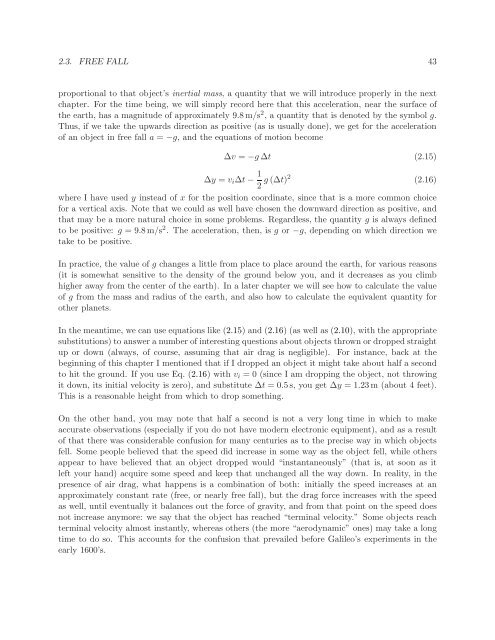University Physics I - Classical Mechanics, 2019
University Physics I - Classical Mechanics, 2019
University Physics I - Classical Mechanics, 2019
Create successful ePaper yourself
Turn your PDF publications into a flip-book with our unique Google optimized e-Paper software.
2.3. FREE FALL 43<br />
proportional to that object’s inertial mass, a quantity that we will introduce properly in the next<br />
chapter. For the time being, we will simply record here that this acceleration, near the surface of<br />
the earth, has a magnitude of approximately 9.8m/s 2 , a quantity that is denoted by the symbol g.<br />
Thus, if we take the upwards direction as positive (as is usually done), we get for the acceleration<br />
of an object in free fall a = −g, and the equations of motion become<br />
Δv = −g Δt (2.15)<br />
Δy = v i Δt − 1 2 g (Δt)2 (2.16)<br />
where I have used y instead of x for the position coordinate, since that is a more common choice<br />
for a vertical axis. Note that we could as well have chosen the downward direction as positive, and<br />
that may be a more natural choice in some problems. Regardless, the quantity g is always defined<br />
to be positive: g =9.8m/s 2 . The acceleration, then, is g or −g, depending on which direction we<br />
take to be positive.<br />
In practice, the value of g changes a little from place to place around the earth, for various reasons<br />
(it is somewhat sensitive to the density of the ground below you, and it decreases as you climb<br />
higher away from the center of the earth). In a later chapter we will see how to calculate the value<br />
of g from the mass and radius of the earth, and also how to calculate the equivalent quantity for<br />
other planets.<br />
In the meantime, we can use equations like (2.15) and(2.16) (as well as (2.10), with the appropriate<br />
substitutions) to answer a number of interesting questions about objects thrown or dropped straight<br />
up or down (always, of course, assuming that air drag is negligible). For instance, back at the<br />
beginning of this chapter I mentioned that if I dropped an object it might take about half a second<br />
to hit the ground. If you use Eq. (2.16) withv i = 0 (since I am dropping the object, not throwing<br />
it down, its initial velocity is zero), and substitute Δt =0.5 s, you get Δy =1.23 m (about 4 feet).<br />
This is a reasonable height from which to drop something.<br />
On the other hand, you may note that half a second is not a very long time in which to make<br />
accurate observations (especially if you do not have modern electronic equipment), and as a result<br />
of that there was considerable confusion for many centuries as to the precise way in which objects<br />
fell. Some people believed that the speed did increase in some way as the object fell, while others<br />
appear to have believed that an object dropped would “instantaneously” (that is, at soon as it<br />
left your hand) acquire some speed and keep that unchanged all the way down. In reality, in the<br />
presence of air drag, what happens is a combination of both: initially the speed increases at an<br />
approximately constant rate (free, or nearly free fall), but the drag force increases with the speed<br />
as well, until eventually it balances out the force of gravity, and from that point on the speed does<br />
not increase anymore: we say that the object has reached “terminal velocity.” Some objects reach<br />
terminal velocity almost instantly, whereas others (the more “aerodynamic” ones) may take a long<br />
time to do so. This accounts for the confusion that prevailed before Galileo’s experiments in the<br />
early 1600’s.


















